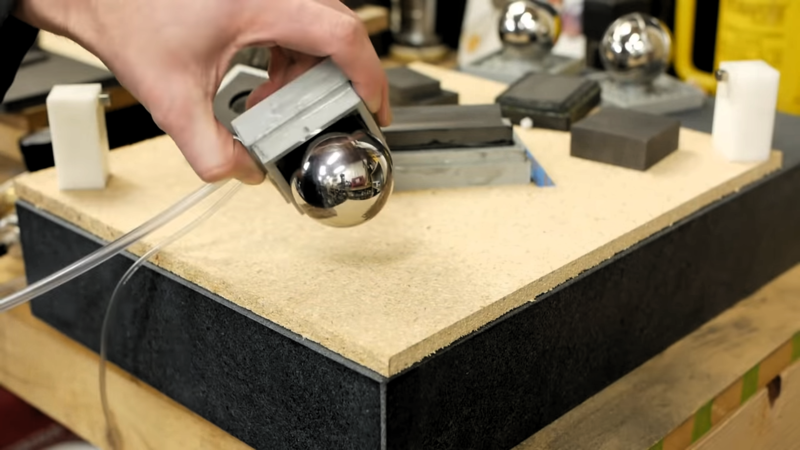We’ve got to admit that watching [Ben Krasnow]’s new video on air bearings is tough. We found our eyes constantly checking the spherical air bearing in the foreground, which for the first eight minutes of the video just kept going. It was strangely hypnotic, and made it hard to concentrate on all the other cool stuff [Ben] was up to.
If the topic of air bearings seems familiar, it might be because we recently reported on DIY air bearings made from used EDM electrodes. [Ben] saw that too, and dusted off his old air bearing project. Literally, as it turns out, because the graphite blocks whose porosity and softness make them the perfect material for air bearings also makes for a dusty workshop. We’d recommend breathing protection of some sort while machining graphite. In addition to simple puck bearings, [Ben] came up with more complicated designs, including the aforementioned spherical bearing. He used the steel ball itself as a precision tool to grind the graphite out, first by coating it with abrasive and then by cutting grooves in it to act like a file. A cylindrical bearing was also cut, this time with sandpaper glued directly to the ground steel rod that would seat in the bearing.
[Ben]’s other innovation is vacuum preloading, where he applies both vacuum and pressure to the bearing plenum. The vacuum provides the force needed to capture the moving element while the pressure bears the load. It’s a careful balancing act, but it works well enough to capture the large steel ball and keep it turning effortlessly.
We really liked [Ben]’s take on air bearings, especially his thoughts on creating fully enclosed cylindrical bearings. Those could be useful for low-friction linear drives, and we look forward to seeing more on those.
















Just roughly taper the end of the rod for the fully enclosed bearing. Connect the pressurised air [ perhaps at slightly reduced pressure ] and then the tooling marks of the taper will do the cutting, it will self center, the outer diameter will be untouched and you’ll save as much of your raw material as possible.
I wonder if this gives a benefit compared to traditional bearings when taking all parts into the equation. So the basic question is: Does it save energy replacing a traditional bearing with an air bearing? Therfore you need to know how much a traditional bearing absorbs compared to an air bearing plus the energy needed to generate the pressure. Do you have any clue what the result is? My feeling is that the traditional bearings are still more efficient. However air bearings can still be useful for e.g. precise positioning of an object.
For a start you’d have to have a good concept of what “traditional” bearings cost you. Without specific steps to prevent and minimise it an IC engine can waste 2-5 HP just thrashing oil around, besides what the pump costs to drive.
In general: probably.
There’s a lot of context dependent things you need to consider. Lots of things have dual bearing systems. Air bearings are great once you reach operating speed but below that they’re no better than direct metal contact. In an ideal air bearing simply using it creates the needed pressure. So it’s not about generating pressure, it’s about reaching the needed surface speed before things start to heat up and gall.
You’re thinking of aerodynamic bearings, which are a different ballgame. The air bearings here are aerostatic, and rely on a compressed air-feed to maintain liftoff. Under normal circumstances, surface speed has virtually no impact on their operation.
Your intuition is basically correct. Assuming they’re operating within spec, lubricated rolling-element bearings are almost always more efficient (often MUCH more efficient), though their advantage declines as surface speeds rise.